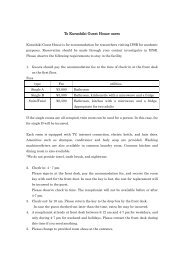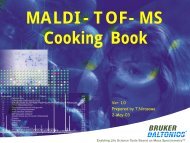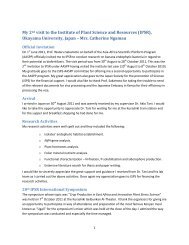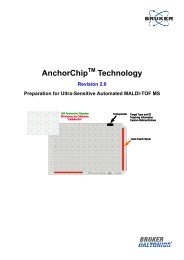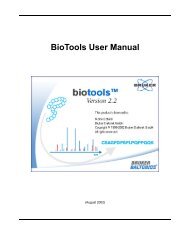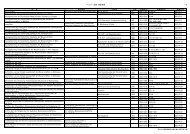Institute of Plant Science and Resources
Institute of Plant Science and Resources
Institute of Plant Science and Resources
Create successful ePaper yourself
Turn your PDF publications into a flip-book with our unique Google optimized e-Paper software.
Soil Stress Unit<br />
Group <strong>of</strong> <strong>Plant</strong> Stress Physiology<br />
Pr<strong>of</strong>essor<br />
Jian Feng Ma<br />
Assistant Pr<strong>of</strong>essor Naoki Yamaji<br />
Crop production on 70% <strong>of</strong> the world’s soil is limited by mineral stresses, which include<br />
deficiency <strong>of</strong> essential elements <strong>and</strong>/or excess <strong>of</strong> essential <strong>and</strong> other elements. To improve crop<br />
production on these problem soils, our group specifically examines the response <strong>of</strong> plants to<br />
mineral stresses, especially for underst<strong>and</strong>ing the tolerance mechanisms from the gene to the whole<br />
plant level.<br />
Tolerance mechanisms <strong>of</strong> Al-toxicity<br />
In acidic soil, toxicity <strong>of</strong> aluminum ion<br />
(Al 3+ ) is the major factor limiting crop<br />
production. However, some species have<br />
Beneficial effects <strong>of</strong> silicon<br />
In fact, Si is the only element which alleviates<br />
multiple plant stresses including diseases, pests,<br />
<strong>and</strong> lodging. Rice is a typical Si-accumulating plant.<br />
It requires great amount <strong>of</strong> Si for healthy growth.<br />
+Si<br />
–Si<br />
Wild type<br />
low-Si<br />
mutant<br />
(lsi1)<br />
Suppression <strong>of</strong> leaf blast Effect on grain discoloration<br />
Molecular mechanism <strong>of</strong> rice Si uptake<br />
The Si influx <strong>and</strong> efflux transporters Lsi1 <strong>and</strong><br />
Lsi2 are localized<br />
at opposite sides<br />
<strong>of</strong> the root<br />
exodermis <strong>and</strong><br />
endodermis.<br />
The Si transported<br />
into the cells by<br />
Lsi1 is exported<br />
by Lsi2 to reach<br />
the stele.<br />
evolved various strategies<br />
to detoxify Al.<br />
The Al-tolerant cultivars <strong>of</strong><br />
barley secrete citrate from<br />
the roots, which is mediated<br />
by an Al-activated citrate<br />
transporter HvAACT1.<br />
pH<br />
5.0 4.5<br />
HvAACT1<br />
Tolerance mechanism <strong>of</strong> Fe-deficiency stress<br />
Gramineous plants acquire insoluble soil iron by<br />
secreting mugineic acids (MAs) as an iron<br />
chelator from the roots. Barley has a specific<br />
transporter, HvYS1, for Fe(III)-MA complex at<br />
the root epidermis.<br />
Rhizosphere<br />
Root<br />
Insoluble<br />
Fe(III)<br />
MA<br />
Fe(III)-MA<br />
X<br />
YS<br />
1<br />
R 1<br />
HN<br />
MA<br />
COOH<br />
R 2<br />
COOH<br />
NH<br />
Fe(III)-MA<br />
COOH<br />
OH<br />
HvYS1<br />
Metal-accumulating plants<br />
<strong>Plant</strong> growth is usually inhibited by metals at<br />
high concentrations. However, a few plant<br />
species are known to accumulate metals at<br />
high concentrations without exhibiting<br />
symptoms <strong>of</strong> toxicity. Hydrangea (left) <strong>and</strong><br />
Thlaspi caerulescens (right) respectively<br />
represent two examples <strong>of</strong> Al-accumulators<br />
<strong>and</strong> Cd <strong>and</strong> Zn hyperaccumulators,<br />
respectively. They detoxify metals internally<br />
by forming non-phytotoxic complexes with<br />
lig<strong>and</strong>s <strong>and</strong>/or sequestering <strong>of</strong> the metals to<br />
the vacuoles.



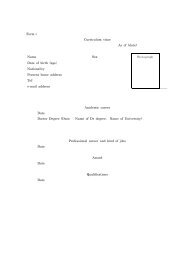
![[Application Forms to Tenure-track Assistant Professor] Applicants ...](https://img.yumpu.com/36047313/1/184x260/application-forms-to-tenure-track-assistant-professor-applicants-.jpg?quality=85)
